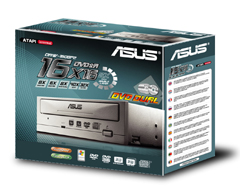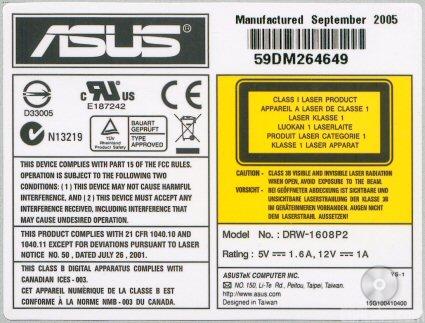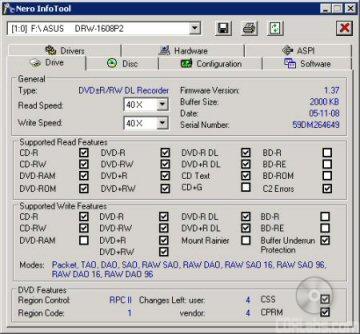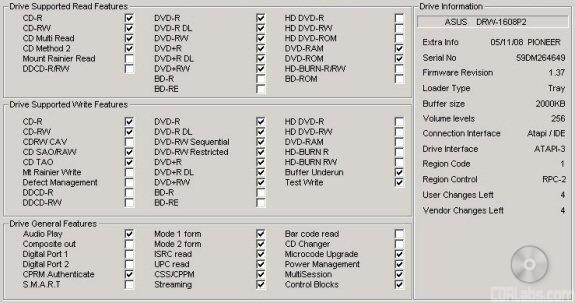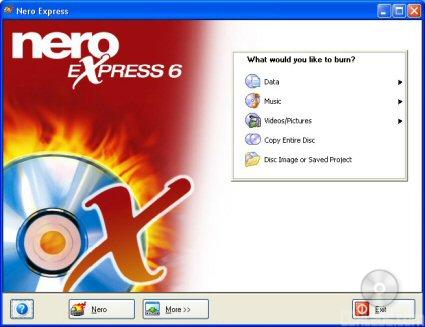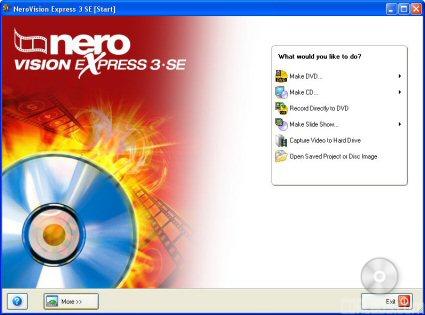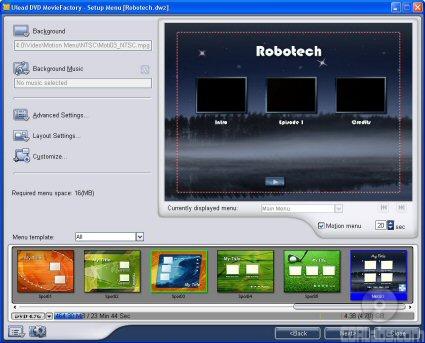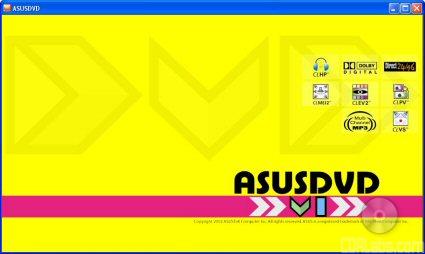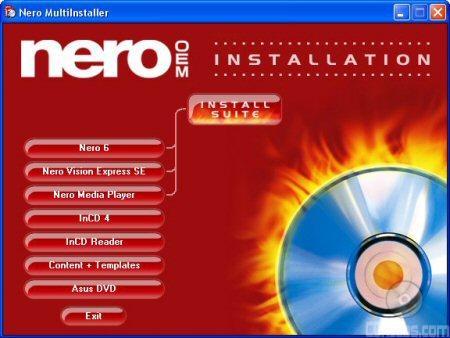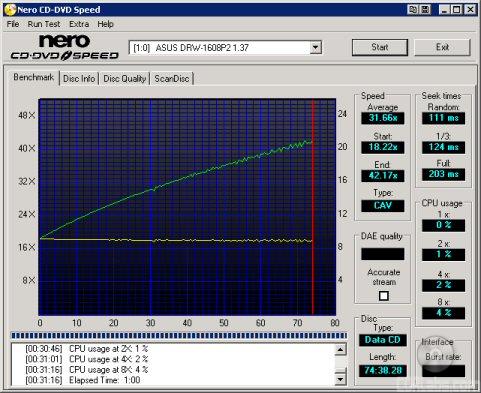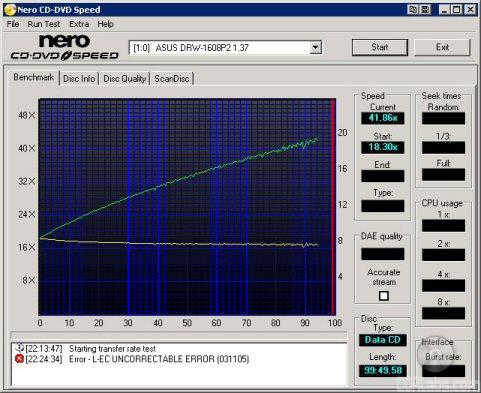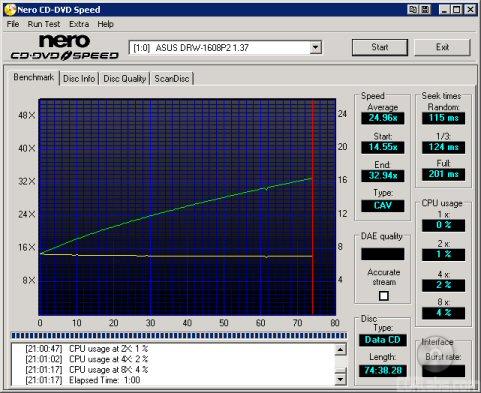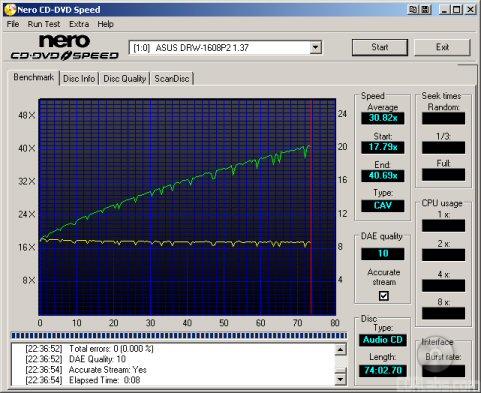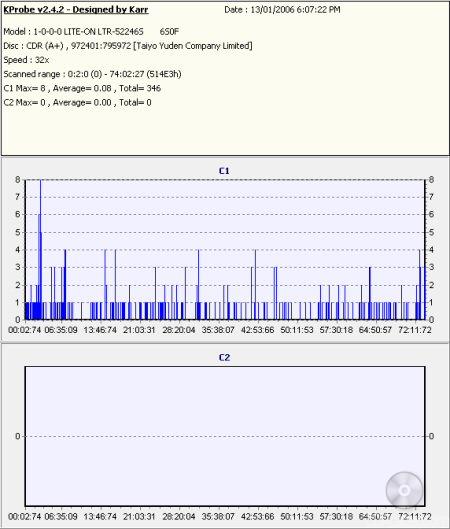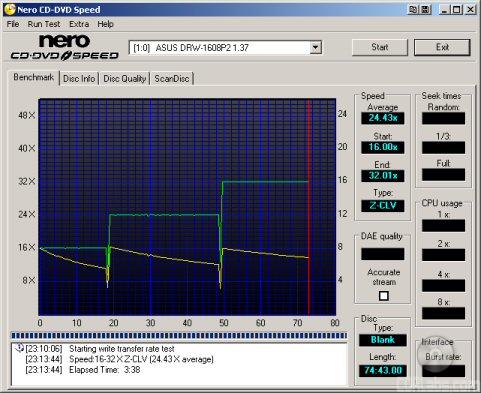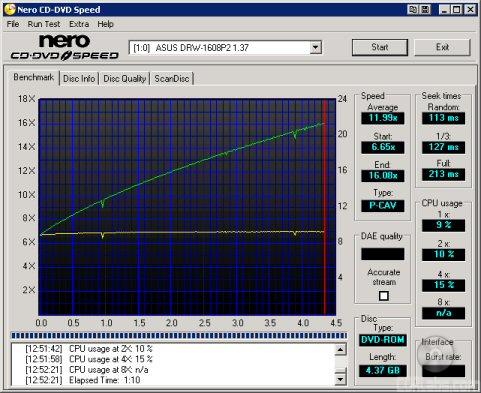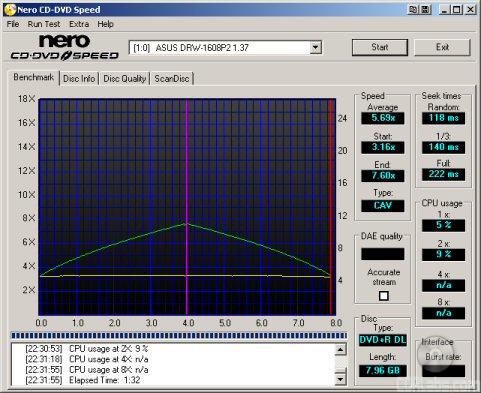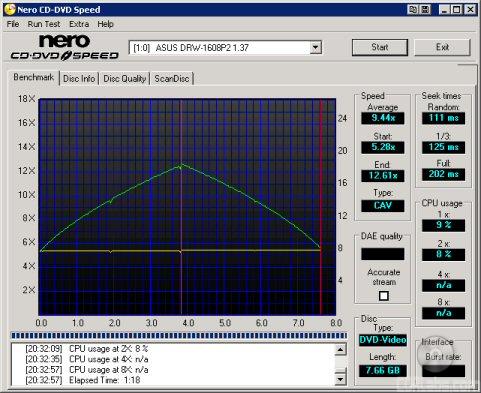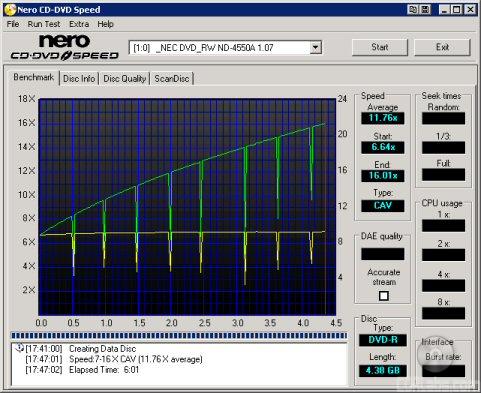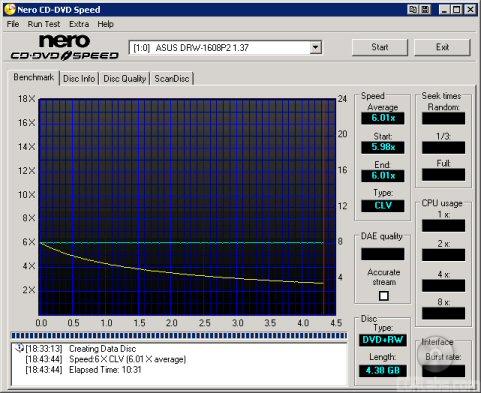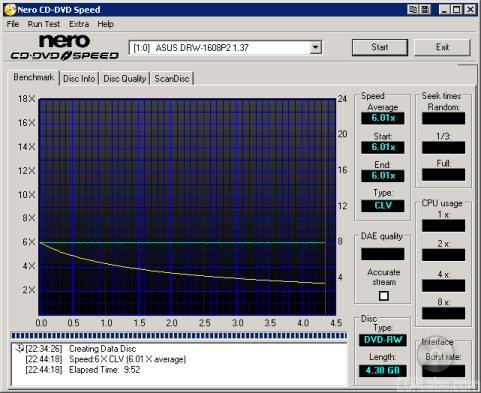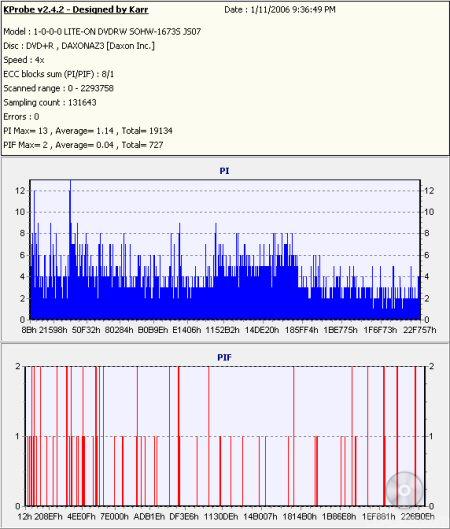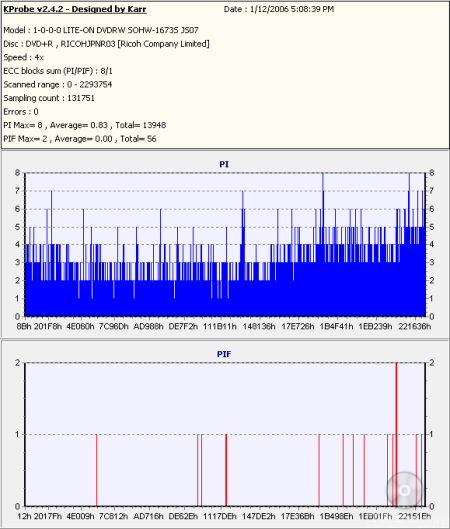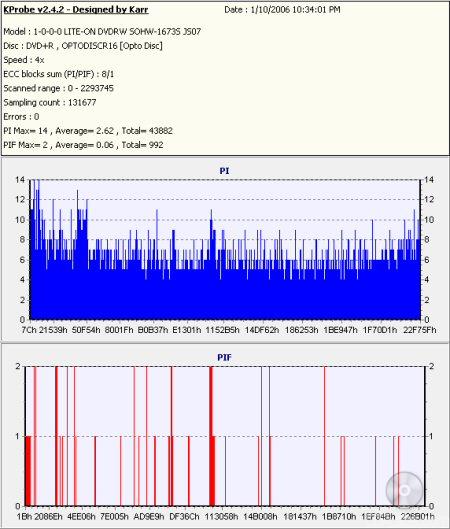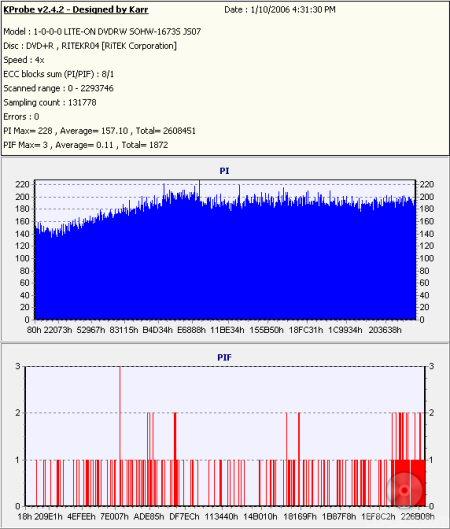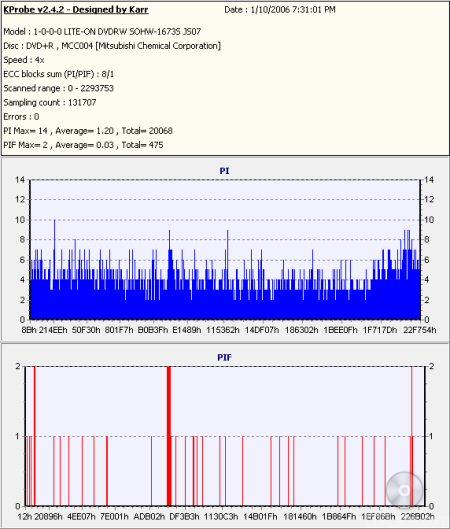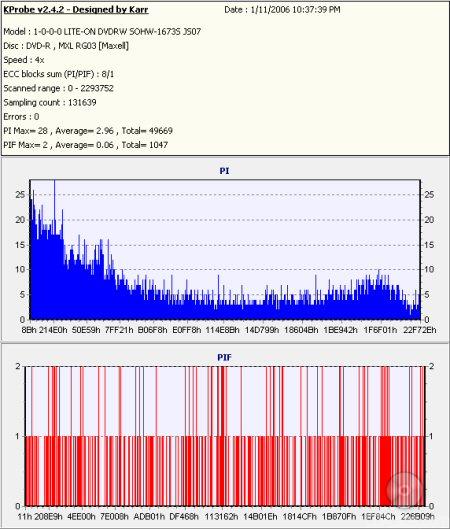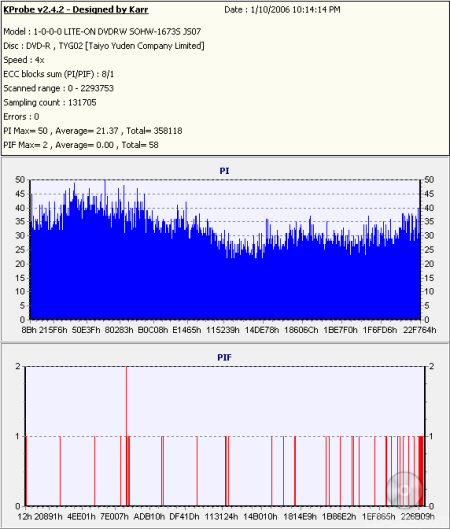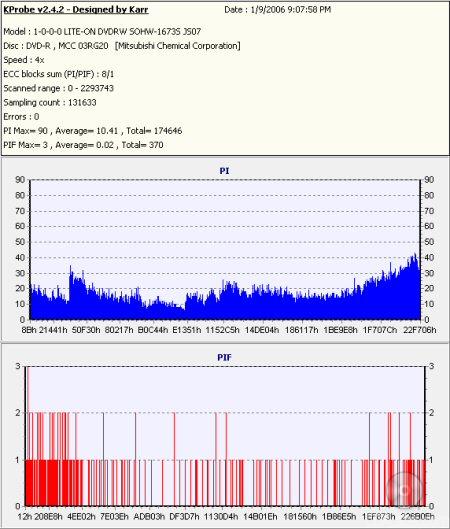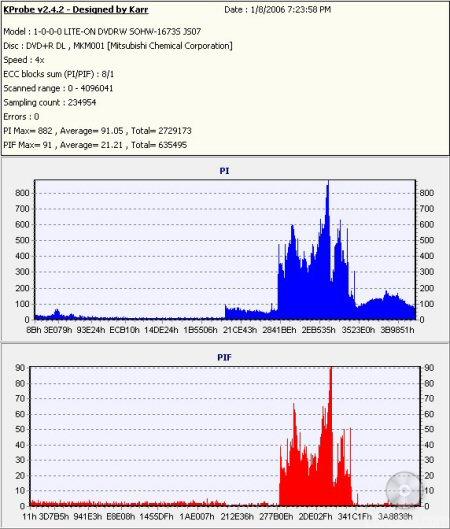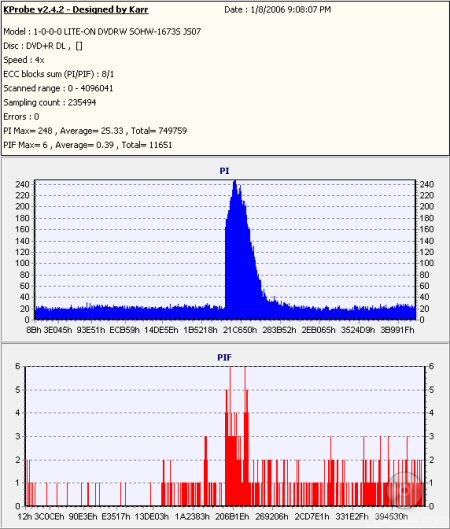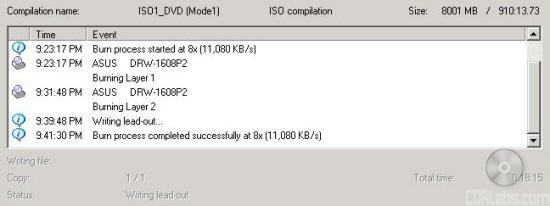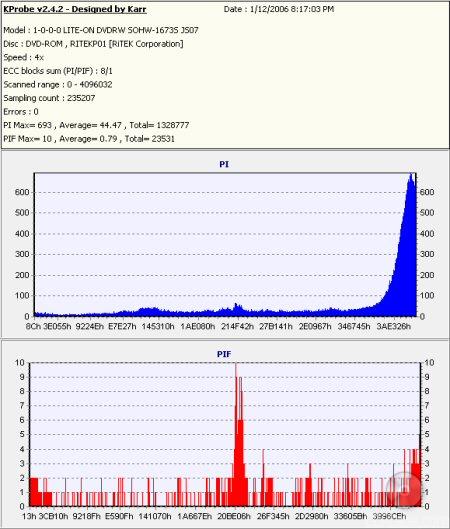
Model: ASUS DRW-1608P2 16x DVD±RW
Manufacturer: ASUSTeK Computer, Inc
An industry veteran with more than 15 years of experience, ASUS is recognized as one of the world's leading manufacturers of computer components. While best known for their motherboards and video cards, ASUS has started to expand into other areas, including the optical storage industry. Over the past few years, they've introduced a number of products for the portable and desktop markets. With their innovative technologies and impressive performance, these drives have been popular right from the start.

With features and specs like this, it's hard not to be impressed by ASUS's new DVD writer. But as you all know by now, we're not ones to take things like this at face value. In this review, we'll take a closer look at the DRW-160P2's features and then see how it compares to some of the 16x DVD±RW drives from the competition. Does the DRW-1608P2 have what it takes? Is it the fastest DVD writer around? Keep reading as we find out.
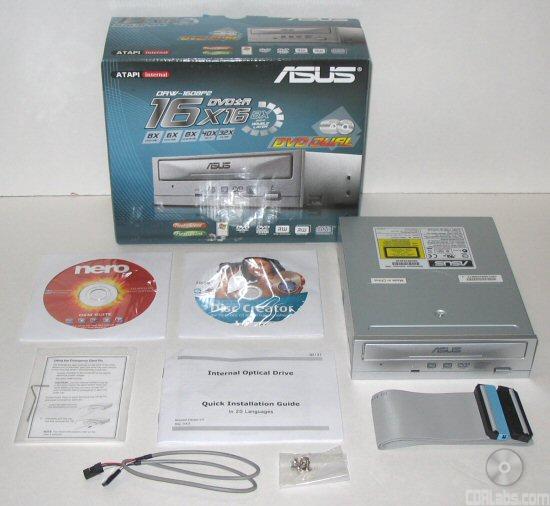
What's in the box?:
- ASUS DRW-1608P2 16x DVD±RW Drive
- Quick Setup Guide
- Nero Software CD
- Ulead Disc Creator CD
- Audio Cable
- Mounting Screws
- IDE Cable
- Emergency Ejection Tool
Physical Features:
The drive ASUS sent us for this review was manufactured in September of 2005 and had firmware 1.17.For this review the drive's firmware has been updated to version 1.37.
From the front, the DRW-1608P2 looks very similar to ASUS's previous 16x DVD±RW drives, the DRW-1604P and DRW-1608P. While there are a few slight differences, all three drives share the same basic design and have many of the same logos. Along with the "ASUS" logo on the tray, you can see a few showing support for DVD-R/RW, DVD+ReWritable and Ultra Speed CD-RW media.
Below the tray you can see the DRW-1608P2's single LED. This "BUSY" indicator lights up green whenever the drive is reading or writing.
The rear of the DRW-1608P2 looks very similar to some of the other Pioneer based DVD writers we've reviewed. By looking at the picture below you can see the drive's IDE interface, power connector and analog audio output connector.
Starting from the left of the IDE connection you'll see the jumper switch for master, slave and cable select. By default the drive's jumper comes set to master. Next to the jumper block is the analog audio connector.
Technical Specs:
Most of the specs below have been taken from ASUS's website and the manual that came with the drive.
| ASUS DRW-1608P2 16x DVD±RW | |
| CD Write Speeds | 40x (CAV) 32x, 24x (Z-CLV) 16x, 10x, 4x (CLV) |
| CD Rewrite Speeds | 32x, 24x, 20x (Z-CLV) 16x, 10x, 4x (CLV) |
| DVD+R Write Speeds | 16x (CAV) 12x, 8x (Z-CLV) 6x, 4x, 2.4x (CLV) |
| DVD+RW Write Speeds | 8x (Z-CLV) 6x, 4x, 2.4x (CLV) |
| DVD-R Write Speeds | 16x (CAV) 12x, 8x (Z-CLV) 6x, 4x, 2x, 1x (CLV) |
| DVD-RW Write Speeds | 6x, 4x, 2x, 1x (CLV) |
| DVD+R DL Write Speeds | 8x (Z-CLV) 6x, 4x, 2.4x (CLV) |
| DVD-R DL Write Speeds | 8x (Z-CLV) 6x, 4x, 2x (CLV) |
| CD Read Speeds | 40x Max (CD-ROM/CD-R) 32x Max (CD-RW) |
| DAE Speed | 40x Max |
| DVD Read Speeds | 16x Max (DVD-ROM Single Layer) 12x Max (DVD-ROM Dual Layer) 12x Max (DVD±R) 8x Max (DVD±RW) 8x Max (DVD±R DL) 2x (DVD-RAM) |
| Buffer Size | 2MB |
| Access Times |
120 ms (CD-ROM) 130 ms (DVD-ROM) |
| CD Formats | CD-ROM CD-DA CD-Extra Photo CD Video CD CD-Text CD-R CD-RW |
| DVD Formats | DVD-ROM DVD+R/RW DVD-R/RW DVD+R DL DVD-R DL DVD-RAM |
| CD Recording Modes | Disc At Once Track At Once Session At Once Packet Writing Multi-Session |
| DVD+R and DVD+R DL Recording Modes |
Sequential Recording Multi-Session Recording |
| DVD+RW Recording Modes | Random Recording |
| DVD-R and DVD-R DL Recording Modes |
Disc At Once Incremental Recording Multi-Border Recording |
| DVD-RW Recording Modes | Restricted Overwriting Disc At Once Incremental Recording Multi-Border Recording |
The DRW-1608P2 also has many of the same features found on ASUS's other drives, including support for their FlextraLink, FlextraSpeed and DDSS II technologies. More information on these features can be found in our review of the CRW-5224A.
More Features:
By looking at the picture below, you can see that ASUS's new DVD writer is identified as an "ASUS DRW-1608P2".

The Nero screenshot also shows that the DRW-1608P2 has a maximum CD writing speed of 40x and a 2000KB buffer. This buffer is also backed up by some form of buffer underrun protection. In this case, it is supposedly ASUS's FlextraLink technology. According to Nero, the drive can also write CD-Text and overburn. When testing the drive's capacity I found that the drive was able to overburn up to 94:27with CompUSA's 99 minute CD-R media.

While the DRW-1608P2 supports RAW-DAO recording, it cannot do EFM encoding correctly. Using CloneCD version 4.2.0.2 Iwas able to backup some older SafeDisc 2 protected titles like Max Payne by enabling AWS. Unfortunately, titles protected by SafeDisc 2.51 and newer, like Serious Sam: The Second Encounter, were not playable in all drives, even with AWS enabled.
Here is a screen shot from Nero's InfoTool. This program queries the drive to see what its reading and writing capabilities are. InfoTool had no problems detecting the DRW-1608P2's maximum reading and writing speeds, recording modes, buffer underrun protection and 2MB buffer.
InfoTool also shows that the DRW-1608P2 is an RPC-2 DVD drive. This means that the drive's region is stored in the firmware. The drive's region can be changed five times and after that it cannot be changed anymore. A patched RPC-1 firmware can be downloaded here. Just keep in mind that it is not supported by ASUS nor by CDRLabs. Use it at your own risk.
While InfoTool gives us a quick glance at the DRW-1608P2's features, DVDINFOpro provides a little more information on some of the drive's reading and writing capabilities. By looking at the screenshot above you can see that while ASUS's new drive can read and write to both DVD+R DL and DVD-R DL media, it does not support the Mt. Rainier format.
The DRW-1608P2 doesn't let you set the book type of single layer DVD+R or DVD+RW media. However, the drive automatically sets the book type for DVD+R DL discs to "DVD-ROM". This greatly reduces compatibility problems, especially with older DVD players.
The DRW-1608P2's software bundle is similar to what ASUS included with the DRW-1608P. The two CD's that come with the drive contain a number of different applications from Nero including Nero Express 6, NeroVision Express 2 SE, Nero Media Player, and InCD as well as Ulead's DVD MovieFactory 4 suite.
Nero Express 6 - With Nero Express, Nero has taken the features and performance people have come to expect from Nero Burning Rom and combined them with a user friendly interface. While the interface has been simplified, Nero Express still supports more advanced features like VCD and DVD creation, CD/DVD duplication, overburning, CD-Text and realtime audio filters.
The version of Nero Express that ASUS included with their new DVD±RW drive is 6.6.0.14. You can download the latest version of the software from Nero's website.
NeroVision Express 3 SE - NeroVision Express 3 is Nero's video authoring application. Using a user friendly interface very similar to that of Nero Express, NeroVision Express makes it easy for users to capture, edit and then burn their favorite videos to VCD, SVCD or DVD or export it to Nero Digital format.
NeroVision Express also lets users add things like transitions, custom backgrounds, animated menus and text effects. You can even use it to turn your photos into custom slide shows.
Nero Media Player - Nero Media Player features on-the-fly encoding of audio CD's to MP3, HE-AAC, TwinVQ, WMA, and WAV format.The MP3 encoder uses the latest audio codec technology from Fraunhofer.While most of the plugins are unrestricted, the MP3 encoder included with this version of the program is limited to only 30 audio tracks.If you need to encode more you will probably want to upgrade to Nero's NeroMIX.
InCD 4 - InCD is Nero's packet writing software. Like Roxio's Drag-to-Disc or Sonic's DLA, it allows a person to use their CD-RW drive as a big floppy disk. The person can then drag and drop files onto a CD-RW or DVD±RW disc. Many people consider InCD to be one of the best packet writing tools because of its simplicity and performance.
Ulead DVD MovieFactory 4 SE - With Ulead's DVD MovieFactory you can create your own CD's and DVD's quickly and easily. Right from the start, MovieFactory gives you a number of options. From here you can create a new compilation, copy or edit an existing disc, or record video directly to CD or DVD.
Adding movie clips to your current project is as easy as drag and drop. MovieFactory lets you take any MPEG-1, MPEG-2, AVI, VOB or QuickTime video clip and add it to your project. After that you can add your own custom menus, backgrounds, fonts and music or use one of the included templates.
Ulead's MovieFactory will also let you transfer video from your camcorder or TV tuner directly to disc. Just choose your menu template and MovieFactory will capture the video and burn it to CD or DVD automatically.
ASUSTek ASUSDVD - The DRW-1608P2 also comes with ASUS's own DVD playback software, ASUSDVD. Based on CyberLink's PowerDVD, ASUSDVD offers a complete set of navigation commands, including advanced features like multi-angle viewing, dual subtitle display, digital zoom and parental controls.
Along with DVD movies, ASUSDVD can be used to play back your VCD's, SVCD's or whatever video files you might have on your hard drive. Unfortunately, the version of ASUSDVD included with the DRW-1608P2 only supports 2 speaker output. If you want to take advantage of DVD's encoded with DTS or use Dolby Pro Logic II, you'll probably want to pick up a retail copy of PowerDVD or WinDVD.
While affordably priced, ASUS's new DVD writer delivers a good number of features. Like the Pioneer drive it's based on, the DRW-1608P2 sports some of the fastest DVD reading and writing speeds available. The drive is capable of 16x DVD±R, 8x DVD+RW and 6x DVD-RW writing speeds and a maximum DVD read speed of 16x. On top of that, it can write to both DVD+R DL and DVD-R DL media at 8x. The DRW-1608P2 also includes features like a 2MB buffer, support for some sort of buffer underrun protection and a software bundle from Nero and Ulead. Unfortunately, it lacks bitsetting support for single layer DVD+R and DVD+RW media. Even then, the ASUS DRW-1608P2 scores a solid 8 out of 10 for its features.
Installing ASUS's new DVD writer in our test computer took only a couple of minutes. After taking the DRW-1608P2 out of the box, I left the jumper set to master and installed it on the secondary IDE chain by connecting the IDE cable and power connector. When I turned on the computer the BIOS detected it as a drive supporting UDMA 66. The only thing left to do was to go into Device Manager and make sure DMA was enabled. With a drive like the DRW-1608P2, enabling DMA is a must if you want to get the best reading and writing performance possible.
Software Installation:
As I mentioned earlier, the DRW-1608P2 comes with two CD's full of software. The first of these contains a few different applications from Nero and ASUS. If you have autorun enabled on your computer, the menu pictured below will automatically come up when you insert the disc.
By now most of you should be pretty familiar with this menu. From here you can choose to install Nero Express,NeroVision Express SE, Nero Media Player, InCD 4, the InCD Reader or ASUS DVD. Simply click the name of the application you want to install, and its setup program will start up automatically. Once you reboot, you'll be ready to start burning your own discs.
The second disc contains Ulead's DVD MovieFactory 4 suite. Like the other software, the installation process is fairly straightforward. All you need to do is choose what language you want and pick your installation options.By default the setup program will install the entire suite onto your computer. If you don't want to install the entire suite, select the custom installation. From here you can choose the components you want to install.
The Documentation:
The DRW-1608P2 doesn't offer much in the way of documentation. The closest thing to a manual is the drive's "Quick Installation Guide". This small, fold out guide is broken up into 20 different languages with each language getting about a page worth of instructions. While these instructions take the user step by step through the installation process, the small diagrams prevent them from being very useful. Also, if you're looking for things like the DRW-1608P2's specs or system requirements, you'll have to check the back of the box or visit ASUS's website. You won't find that information in the guide.
Like the other ASUS drives we've looked at, the DRW-1608P2 was very easy to install. There were no problems getting the drive or the software installed and working correctly. Nevertheless, I must admit that I was a little disappointed by the documentation. The brief instructions probably won't phase more experienced users. However, they might leave others in the dark. With this in mind, I give the installation a 7 out of a possible 10.
While CPU, memory, OS and other variables don't often make a huge difference, there are some nonetheless. We have a computer that is used only for testing hardware. We do this so all tests can be compared reliably.
Test System:
| CPU: | AMD Athlon 64 3200+ 2.0GHz | |
| Motherboard: | ASUS K8V SE Deluxe with BIOS 1003 | |
| Memory: | 2 x 256MB Kingston PC3200 | |
| Video Card: | XFX NVIDIA GeForce FX5200 - ForceWare v56.72 | |
| Hard Drive: | Hitachi Deskstar 7K80 80GB SATA 7200RPM | |
| Operating System: | Windows XP SP1 - VIA Hyperion 4in1 v4.51 |
For DVD writers the performance tests are broken down into four sections: CD read, CD write, DVD read and DVD write tests. Each benchmark test has been run three times. The score given is an average of the three. DMA has been enabled in device manager for all IDE devices supporting it.
CD Read Tests: For the read performance section of the CD-ROM benchmarks, CD WinBench 99 v3.0 and CD Speed v4.10 are used to test read speeds, seek times and CPU usage. For DAE testing both CD Speed and CD DAE are used. CD Speed is used to give an overall DAE speed rating and CD DAE is used to give the track by track extraction speeds and to check the extracted tracks for errors the drive may have created.
CD Write Tests: To test the write speeds, Nero Burning Rom is used to write 650MB and 700MB to our test media. Times are recorded. To test rewrite scores, Nero is used again to time how long it takes to write 400MB of random files and directories. Then Sonic's DLA is used to test packet writing speeds. The same files are copied and pasted in Windows Explorer and timed.
DVD Read Tests: For the read performance section of the DVD benchmarks CD Speed v4.10 is used to test read speeds, seek times, and CPU usage.
DVD Write Tests: To test the DVD write speeds, Nero Burning Rom is used to write 4GB to our test media. Times are recorded. Then Sonic's DLA is used to test packet writing speeds. The same files are copied and pasted in Windows Explorer and timed.
CD Winbench 99 Scores:
| ASUS DRW-1608P2 |
NEC ND-4550A |
LG GSA-4167B |
Sony DRU-810A |
|
| CD Winbench 99 | 1285 KB/sec | 1530 KB/sec | 1213 KB/sec | 1448 KB/sec |
| Transfer Rate: Inside | 2143 KB/sec | 3060 KB/sec | 3210 KB/sec | 2853 KB/sec |
| Transfer Rate: Outside | 5720 KB/sec | 6400 KB/sec | 6373 KB/sec | 6530 KB/sec |
| Random Access Time | 102ms | 101ms | 102ms | 117ms |
| CPU Utilization | 0.34% | 1.25% | 0.24% | 0.25% |
The CD Winbench test is as close as we can get to testing every day usage. It fires off eight different applications using scripts. This tries to mimic the activities of a person loading these programs onto their own computer.
ASUS's new DVD writer didn't do as well as some of the other drives in our CD Winbench tests. The DRW-1608P2's overall score was not only very low, its 40x CD read speed put it at a disadvantage in the transfer rate tests. As you can see, it started reading at 14.3x (2143 / 150) and reached a maximum speed of about 38.1x (5720 / 150).
CD Speed v4.10 - Pressed CD:
For this test I used a pressed CD containing one Mode 1 data track. The disc is 74:38 in size and is full of data and directories.

| ASUS DRW-1608P2 |
NEC ND-4550A |
LG GSA-4167B |
Sony DRU-810A |
|
| Transfer Speed Average: Start: End: |
31.30x 18.12x 41.24x |
35.60x 20.54x 47.09x |
35.63x 20.45x 47.28x |
36.39x 20.64x 48.13x |
| Seek Times Random: 1/3: Full: |
104ms 145ms 222ms |
137ms 145ms 219ms |
114ms 126ms 183ms |
106ms 123ms 176ms |
| CPU Usage 1x: 2x: 4x: 8x: |
1% 1% 3% 6% |
17% 1% 3% 6% |
1% 1% 3% 36% |
1% 1% 3% 6% |
The DRW-1608P2 performed a little better in our CD Speed tests. While still not as fast as the other drives, it had no problems reaching a maximum speed of 41.24x. Unfortunately, its seek times were also higher than we'd like to see.
CD Speed v4.10 - CD-R Media:
For this test I made a copy of our pressed test CD. I used 12x rated Memorex Gold 74 minute media for the tests.
| ASUS DRW-1608P2 |
NEC ND-4550A |
LG GSA-4167B |
Sony DRU-810A |
|
| Transfer Speed Average: Start: End: |
31.66x 18.22x 42.17x |
36.33x 20.83x 48.03x |
36.39x 20.72x 47.99x |
37.23x 20.92x 49.46x |
| Seek Times Random: 1/3: Full: |
112ms 125ms 206ms |
152ms 159ms 250ms |
115ms 127ms 183ms |
109ms 123ms 181ms |
| CPU Usage 1x: 2x: 4x: 8x: |
0% 1% 2% 4% |
17% 1% 3% 6% |
1% 1% 3% 36% |
1% 1% 3% 6% |
The DRW-1608P2 was a little faster when reading CD-R media. While this still wasn't enough to top the other drives, it had no problems reaching a maximum read speed of 42.17x.
Unfortunately, ASUS's new drive had some trouble reading our 99 minute CompUSA media. While the DRW-1608P2 was able to recognize the disc correctly, it would not read beyond the 94 minute mark.
CD Speed v4.10 - CD-RW Media:
For this test I made a copy of a pressed test CD. I used some PNY 80 minute CD-RW media for the tests.
| ASUS DRW-1608P2 |
NEC ND-4550A |
LG GSA-4167B |
Sony DRU-810A |
|
| Transfer Speed Average: Start: End: |
24.96x 14.55x 32.94x |
30.78x 17.94x 40.13x |
30.63x 17.47x 40.20x |
30.74x 17.58x 40.58x |
| Seek Times Random: 1/3: Full: |
114ms 123ms 202ms |
153ms 161ms 252ms |
111ms 128ms 202ms |
107ms 120ms 172ms |
| CPU Usage 1x: 2x: 4x: 8x: |
0% 1% 2% 4% |
12% 1% 4% 8% |
1% 1% 3% 25% |
1% 1% 3% 6% |
While the DRW-1608P2 can read pressed and CD-R media at 40x, its CD-RW read speeds are limited to only 32x. As you can see, the drive had no problems reaching this speed in our tests.
CD DAE and CD Speed v4.10 - Pressed CD:
For this test I used Pure Funk. The CD is almost exactly 74 minutes. This helps to squeeze the maximum performance out of the CD.

Exact Audio Copy can tell us a lot about a drive's capabilities. You can see from the screen shot that while ASUS's new DVD writer supports accurate stream and has the ability to cache audio data, it does not have the ability to retrieve C2 error information. This is different than what we saw with InfoTool. If you remember back, it showed that the DRW-1608P2 could return C2 errors.
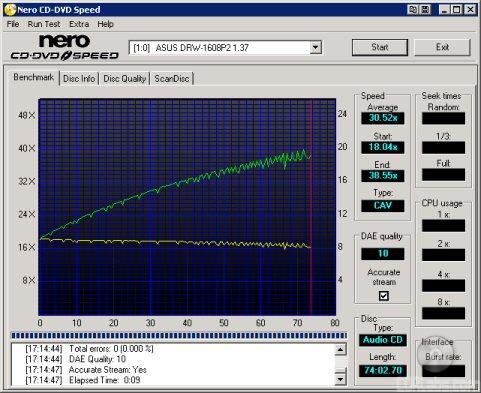
| CD Speed | ASUS DRW-1608P2 |
NEC ND-4550A |
LG GSA-4167B |
Sony DRU-810A |
| Average: Start: End: DAE Quality: Accurate Stream: |
30.52x 18.04x 38.58x 10 Yes |
30.94x 17.99x 40.12x 10 Yes |
30.81x 17.50x 40.79x 10 Yes |
36.76x 20.90x 48.59x 10 Yes |
The DRW-1608P2 didn't do as well as I expected in our DAE tests. Like the Pioneer DVR-R100, it had a tendency to slow near the end, preventing it from reaching 40x.
To get a better look at the quality of the extracted audio we use CD DAE. CD DAE is actually designed to be an audio ripping program. It converts the CD-DA on the CD to .wav files. We use it in our testing because it can also be used as a quick and easy way to test the quality. Where CD Speed tests the DAE as one large session, CD DAE extracts each CD track individually. It actually extracts each track twice and then compares them to check for any errors. Every error a drive creates could be a hiss or pop you would hear later in the audio tracks.
| CD DAE | ASUS DRW-1608P2 |
NEC ND-4550A |
LG GSA-4167B |
Sony DRU-810A |
| Average: Min: Max: |
28.4x 18.8x 36.8x |
29.3x 18.6x 39.5x |
29.2x 18.5x 39.8x |
34.3x 22.0x 47.1x |
| Errors | 0 | 0 | 0 | 0 |
ASUS's new writer started out a little faster when extracting our test CD with CD DAE. Unfortunately, it slowed down during the later tracks, preventing it from reaching its rated speed.
CD DAE and CD Speed v4.10 - CD-R Media:
For this test I used a copy of the Pure Funk CD. It's burned onto the same Memorex Gold 74 minute media I used in the CD Speed tests.
| CD Speed | ASUS DRW-1608P2 |
NEC ND-4550A |
LG GSA-4167B |
Sony DRU-810A |
| Average: Start: End: DAE Quality: Accurate Stream: |
30.82x 17.79x 40.69x 10 Yes |
30.67x 17.92x 40.11x 10 Yes |
30.53x 17.39x 40.35x 10 Yes |
36.41x 20.91x 47.99x 10 Yes |
The DRW-1608P2 did much better here. While not as fast as the drive from Sony, it had no problems reaching amaximum DAE speed of 40x in our tests. So how did it do in CD Speed's advanced DAE tests? Take a look below.
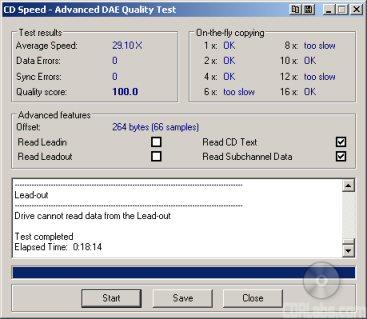
ASUS's new DVD writer completed CD Speed's advanced DAE tests with an average score of 29.10x. The drive did not create any errors, but for whatever reason, it was not able to pass all of the on-the-fly copying tests. In the advanced features tests, the DRW-1608P2 was able to read the CD-Text and subchannel data but was not able to read the lead in or lead out sections of the CD.
| CD DAE | ASUS DRW-1608P2 |
NEC ND-4550A |
LG GSA-4167B |
Sony DRU-810A |
| Average: Min: Max: |
28.5x 18.7x 39.5x |
29.1x 18.6x 39.5x |
28.9x 18.4x 39.2x |
34.0x 22.0x 46.5x |
| Errors | 0 | 0 | 0 | 0 |
To see how well ASUS's new drive can read scratched and dirty discs, I used CD Speed's ScanDisc utility to see how many sectors were damaged or unreadable. This is a very rough, but good way to test the drive's error correcting abilities.
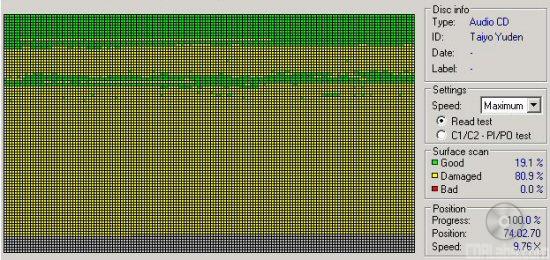
CD Speed - ScanDisc
The DRW-1608P2 didn't handle scratched discs as well as some of the other DVD writers we've looked at recently. While there weren't any unreadable sectors on the disc, the drive considered more than 80% of the CD to be "damaged."
You can also get an idea of how well the drive can read scratched and dirty discs by using CD DAE. CD DAE will extract the audio tracks twice and then compare them. From this information we can see what the drive's average speed was and how many errors it generated.
| CD DAE | Avg. Speed | Errors | % of Disc |
|
ASUS DRW-1608P2 |
27.3x | 21813871 | 2.78% |
|
NEC ND-4550A |
8.2x | 167095050 | 21.32% |
|
LG GSA-4167B |
28.5x | 4844005 | 0.62% |
|
Sony DRU-810A |
5.9x | 5452039 | 0.70% |
The DRW-1608P2 did better this time around. As you can see, the scratches on the disc had little effect on the drive's speed and the number of errors remained relatively low.
CD Write and ReWrite Tests - Nero Burning Rom 6.6.0.16 andDLA 4.95:
For this test I randomly generated 650MB and 700MB of files and directories to test the time it takes the drive to write and close a CD. All of the files are between 1MB and 25MB in size and no more than 10 directories deep. All of the times below include not only the actual writing time, but the lead in and out times too. This gives a more realistic idea of how long it takes to write a CD.

The DRW-1608P2 has a maximum CD writing speed of 40x. To reach this speed, it uses CAV, or Constant Angular Velocity. With Fuji's 48x media, the drive started writing at about 17.78x and reached a maximum speed of 40.10x at the end of the session. This gave ASUS's new DVD±RW an average writing speed of about 30.40x.
To test the DRW-1608P2's writing times, I wrote our test data to some Taiyo Yuden manufactured Fujimedia rated at 48x. The results are below.
| Size in MB | Size in Time | ASUS DRW-1608P2 |
NEC ND-4550A |
LG GSA-4167B |
Sony DRU-810A |
| 651MB | 74:02:55 | 3:16 | 2:57 | 2:58 | 2:40 |
| 701MB | 79:44:21 | 3:23 | 3:03 | 3:03 | 2:50 |
ASUS's new DVD writer went into this test with a slight disadvantage. While the other drives can write CD's at 48x, the DRW-1608P2 has a maximum writing speed of only 40x. Nevertheless, it was able to write an entire 650MB CD in a respectable 3:16.
To test the drive's writing quality I used Lite-On IT's KProbe2. Written by Karr Wang, this utility can be used to test the number of C1 and C2 errors on a disc. For these tests I used a Lite-On LTR-52246S (firmware 6S0F) and read the discs at 32x.
The DRW-1608P2's writing quality is very good. By looking at the KProbe screenshots, you can see that the discs burned by the drive had a low number of C1 errors and there were no C2 errors at all.
For the rewriting tests I created 400MB of files on the hard drive and wrote them in DAO mode using Nero. To test the packet writing speeds I copied and pasted the same files off the hard drive onto a CD-RW disc using DLA from Sonic. Verbatim's 32x Ultra Speed CD-RW media was used for these tests.
While the DRW-1608P2 uses CAV when writing to CD-R discs, it uses Z-CLV, or Zone CLV, when rewriting at 32x. By looking at the screenshot above, you can see that it starts writing at 16x and jumps to 24x at about the 19 minute mark. The drive writes at this speed until about the 49 minute mark. At this point, the writing speed increases to 32x and stays there until the very end of the session.
| Software | ASUS DRW-1608P2 |
NEC ND-4550A |
LG GSA-4167B |
Sony DRU-810A |
| Nero | 2:47 | 2:04 | 2:09 | 1:58 |
| DLA Write | 2:40 | 1:59 | 2:07 | 1:52 |
| DLA Read | 3:54 | 1:12 | 1:13 | 1:12 |
With its Z-CLV writing method, the DRW-1608P2 wasn't as fast as some of the other DVD writers we've looked at. In our tests, ASUS's new drive took 2:47 to write 400MB with Nero and 2:40 to do the same with DLA. Unfortunately, it was even slower when reading back our test data. The DRW-1608P2 took almost 4 minutes to read back all 400MB of files and directories.
| ASUS DRW-1608P2 |
NEC ND-4550A |
LG GSA-4167B |
Sony DRU-810A |
|
| Quick Erase | 24 seconds | 29 seconds | 25 seconds | 26 seconds |
| Full Erase | 3:54 | 3:11 | 3:14 | 3:46 |
The DRW-1608P2 also erases at 32x. While the drive took 3:54 to do a full erase, it had the fastest quick erase time out of the four drives here.
Nero CD Speed v4.10 - DVD-ROM:
A little editorial note here. Like a CD-ROM, you will get different benchmark results depending on what kind of discs you are using. You are probably going to get varying results from a full data disc to a single layer movie disc. You're also going to get different results for single and dual layer discs.
The CD Speed website recommends using a single layer DVD-ROM disc with a capacity of at least 4GB. If you use a dual layer disc you probably won't get the best results because most DVD-ROM drives slow down to read them. Some even slow down to read single layer DVD-Video discs. To make a long story short, I am using a 4.37GB single layer, single sided disc for this test.
| ASUS DRW-1608P2 |
NEC ND-4550A |
LG GSA-4167B |
Sony DRU-810A |
|
| Transfer Speed Average: Start: End: |
11.99x 6.65x 16.08x |
11.94x 6.57x 15.97x |
12.34x 6.80x 16.51x |
12.05x 6.56x 16.17x |
| Seek Times Random: 1/3: Full: |
113ms 126ms 212ms |
136ms 148ms 226ms |
105ms 121ms 189ms |
100ms 109ms 171ms |
| CPU Usage 1x: 2x: 4x: 8x: |
9% 10% 15% n/a |
15% 15% 28% 52% |
6% 12% 23% 43% |
6% 12% 24% 47% |
The DRW-1608P2 performed pretty well when reading single layer DVD-ROM's. In our tests it started reading at 6.65x and reached a maximum transfer speed of about 16.08x.
Nero CD Speed v4.10 - DVD-R, DVD-RW and DVD-RAM:
First, we'll look at the drive's DVD-R and DVD-RW reading performance. For this I made copies of our DVD-ROM test disc using some general use 4x DVD-R and 2x DVD-RW media from Verbatim and then ran our usual DVD read tests with CD Speed. For the DVD-RAM tests, media from Optodisc was used. The results are below.
Verbatim DVD-R
| ASUS DRW-1608P2 |
NEC ND-4550A |
LG GSA-4167B |
Sony DRU-810A |
|
| Transfer Speed Average: Start: End: |
9.37x 5.20x 12.51x |
11.97x 6.60x 16.01x |
7.71x 4.27x 10.31x |
12.08x 6.59x 16.16x |
| Seek Times Random: 1/3: Full: |
117ms 134ms 219ms |
135ms 156ms 248ms |
99ms 119ms 177ms |
106ms 123ms 178ms |
| CPU Usage 1x: 2x: 4x: 8x: |
6% 9% 25% 94% |
16% 17% 31% 62% |
6% 13% 23% 43% |
7% 12% 24% 51% |
Verbatim DVD-RW
| ASUS DRW-1608P2 |
NEC ND-4550A |
LG GSA-4167B |
Sony DRU-810A |
|
| Transfer Speed Average: Start: End: |
6.25x 3.47x 8.35x |
9.81x 5.40x 13.12x |
6.17x 3.41x 8.25x |
9.36x 5.11x 12.54x |
| Seek Times Random: 1/3: Full: |
128ms 146ms 240ms |
124ms 154ms 251ms |
118ms 144ms 213ms |
108ms 124ms 173ms |
| CPU Usage 1x: 2x: 4x: 8x: |
6% 9% 30% 92% |
9% 15% 28% 50% |
6% 11% 22% 42% |
6% 12% 24% 47% |
ASUS's new drive had no problems reading DVD-R and DVD-RW media. In our tests, it was able to read DVD-R media at a respectable 12.51x, but reached a maximum transfer speed of only 8.3x when reading DVD-RW discs.
Verbatim DVD-R DL
| ASUS DRW-1608P2 |
NEC ND-4550A |
LG GSA-4167B |
Sony DRU-810A |
|
| Transfer Speed Average: Start: End: |
5.69x 3.17x 7.59x |
5.47x 3.04x 7.29x |
6.19x 3.44x 8.26x |
9.05x 5.01x 12.07x |
| Seek Times Random: 1/3: Full: |
120ms 134ms 221ms |
211ms 221ms 316ms |
127ms 152ms 220ms |
117ms 137ms 174ms |
| CPU Usage 1x: 2x: 4x: |
5% 18% n/a |
8% 13% n/a |
7% 13% n/a |
6% 12% 24% |
The DRW-1608P2 wasn't as fast when reading Verbatim's 4x DVD-R DL media. As you can see, the drive started reading at 3.17x and reached a maximum transfer speed of 7.59x.
Optodisc 2x DVD-RAM
| ASUS DRW-1608P2 |
NEC ND-4550A |
LG GSA-4167B |
|
| Transfer Speed Average: Start: End: |
1.99x 1.99x 1.99x |
4.99x 4.94x 5.01x |
4.67x 3.02x 5.04x |
| Seek Times Random: 1/3: Full: |
158ms 170ms 255ms |
207ms 195ms 311ms |
141ms 145ms 194ms |
| CPU Usage 1x: 2x: 4x: |
28% 74% n/a |
7% 13% 24% |
21% 32% 53% |
The DRW-1608P2 also has the ability to read DVD-RAM media. While it wasn't able to top the drives from NEC and LG, it reached a maximum read speed of 1.99x in our tests.
Nero CD Speed v4.10 - DVD+R and DVD+RW:
Next we'll look at the drive's DVD+R and DVD+RW reading performance. For this I made a copy of our DVD-ROM test disc using some 4x DVD+R and 2.4x DVD+RW media from Verbatim. I then ran our usual DVD read tests with CD Speed. The results are below.
Verbatim DVD+R
| ASUS DRW-1608P2 |
NEC ND-4550A |
LG GSA-4167B |
Sony DRU-810A |
|
| Transfer Speed Average: Start: End: |
9.36x 5.19x 12.55x |
11.96x 6.60x 16.00x |
7.72x 4.25x 10.32x |
12.10x 6.60x 16.18x |
| Seek Times Random: 1/3: Full: |
119ms 139ms 220ms |
133ms 154ms 250ms |
97ms 121ms 186ms |
106ms 121ms 183ms |
| CPU Usage 1x: 2x: 4x: 8x: |
6% 28% n/a 59% |
16% 17% 34% 65% |
6% 12% 23% 42% |
6% 12% 24% 49% |
Verbatim DVD+RW
| ASUS DRW-1608P2 |
NEC ND-4550A |
LG GSA-4167B |
Sony DRU-810A |
|
| Transfer Speed Average: Start: End: |
6.25x 3.46x 8.36x |
9.81x 5.40x 13.12x |
6.18x 3.42x 8.26x |
9.36x 5.10x 12.50x |
| Seek Times Random: 1/3: Full: |
127ms 136ms 218ms |
128ms 160ms 258ms |
119ms 146ms 212ms |
106ms 121ms 174ms |
| CPU Usage 1x: 2x: 4x: 8x: |
6% 8% 29% 90% |
11% 21% 34% 64% |
7% 13% 25% 46% |
6% 12% 24% 47% |
The DRW-1608P2's performance with DVD+R and DVD+RW media was very similar to what we saw with DVD-R and DVD-RW media. The drive read DVD+R discs at 12.5x and DVD+RW media at 8.3x.
Verbatim DVD+R DL
| ASUS DRW-1608P2 |
NEC ND-4550A |
LG GSA-4167B |
Sony DRU-810A |
|
| Transfer Speed Average: Start: End: |
5.69x 3.16x 7.60x |
5.47x 3.04x 7.30x |
6.20x 3.44x 8.27x |
9.07x 5.01x 12.09x |
| Seek Times Random: 1/3: Full: |
118ms 139ms 221ms |
148ms 185ms 294ms |
123ms 148ms 219ms |
111ms 120ms 173ms |
| CPU Usage 1x: 2x: 4x: |
5% 9% n/a |
7% 12% n/a |
7% 12% n/a |
7% 13% 26% |
Reading Verbatim's double layer DVD+R media wasn't a problem for the DRW-1608P2 either. While not nearly as fast as the drive from Sony, it reached a maximum transfer speed of 7.60x.
Nero CD Speed v4.10 - DVD-Video:
For these tests I am using the US version of Transformers: The Movie on DVD. The disc is over 4GB and single sided.
| ASUS DRW-1608P2 |
NEC ND-4550A |
LG GSA-4167B |
Sony DRU-810A |
|
| Transfer Speed Average: Start: End: |
11.87x 6.58x 15.91x |
11.83x 6.49x 15.82x |
3.64x 2.01x 4.87x |
11.93x 6.51x 15.95x |
| Seek Times Random: 1/3: Full: |
114ms 129ms 214ms |
135ms 147ms 228ms |
117ms 148ms 217ms |
101ms 109ms 171ms |
| CPU Usage 1x: 2x: 4x: 8x: |
8% 10% 15% n/a |
15% 15% 28% 51% |
6% 11% 21% n/a |
6% 12% 24% 47% |
The DRW-1608P2 didn't slow down very much when reading single layer DVD videos. It started out at about 6.58x and reached a maximum read speed of 15.91x. ASUS's new drive was also surprisingly fast when reading dual layer discs. By looking at the screenshot below, you can see that the drive's transfer speeds peaked at an impressive 12.61x.
To see how well the DRW-1608P2 worked as a DVD player, I watched a few scenes from Transformers: The Movie and Star Wars: The Phantom Menace using WinDVD 4 and PowerDVD 5. The drive had no problems playing back these movies with either program and was fairly quiet.
DVD Write and ReWrite Tests - Nero Burning Rom 6.6.0.16 andDLA 4.95:
To test the DVD writing performance of ASUS's new drive I used Verbatim 16x DVD+R, 16x DVD-R, 8x DVD+RW and 6x DVD-RW media. To get the writing times, a 4.38GB image was burned to our test discs using Nero.
When writing to DVD+R and DVD-R media at 16x, the DRW-1608P2 uses CAV. By looking at the screenshots above, you can see that ASUS's new drive starts writing at about 6.64x and accelerates, reaching its maximum speed as it reaches the end of the disc.
According to ASUS, the DRW-1608P2 is capable of 8x DVD+RW and 6x DVD-RW writing speeds. In our tests, the drive had no problems writing to DVD-RW media at 6x. Unfortunately, we could not find any 8x DVD+RW media that would work at the drive's rated speed. We tried 8x DVD+RW media from both Verbatim and Ritek and the writing speeds were limited to 6x and 3.3x respectively.
| ASUS DRW-1608P2 |
NEC ND-4550A |
LG GSA-4167B |
Sony DRU-810A |
|
| DVD+R | 6:21 | 6:10 | 5:31 | 5:52 |
| DVD-R | 6:09 | 6:06 | 5:33 | 6:31 |
| DVD+RW | 9:30 | 7:16 | 7:20 | 7:42 |
| DVD-RW | 9:57 | 10:34 | 9:59 | 10:24 |
While not as fast as some of the other drives when writing to DVD+R discs at 16x, the DRW-1608P2 had no problems holding its own with DVD-R and DVD-RW media. Unfortunately, with its DVD+RW writing speed limited to only 6x, it was considerably slower than the drives from the competition.
To check the media compatibility of the DRW-1608P2, I ran a few tests using some of the media available in my area. The media types, along with the average time it took the drive to write our 4.38GB image, are listed below.
| Manufacturer ID | Max Write Speed |
Average Write Time |
|
| Taiyo Yuden 8x DVD+R | YUDEN000T02 | 12x | 7:40 |
| Daxon 16x DVD+R | DAXONAZ3 | 16x | 6:19 |
| Memorex 16x DVD+R | RICOHJPN R03 | 12x | 8:20 |
| Optodisc 16x DVD+R | OPTODISCR16 | 4x | 14:58 |
| RiDATA 16x DVD+R | RITEKR04 | 4x | 15:00 |
| Verbatim 16x DVD+R | MCC-004 | 16x | 6:21 |
| Maxell 8x DVD-R | MXL RG03 | 12x | 7:22 |
| Taiyo Yuden 8x DVD-R | TYG02 | 12x | 7:23 |
| Daxon 16x DVD-R | DAXON016S | 16x | 6:04 |
| Memorex 16x DVD-R | CMC MAG.AM3 | 16x | 6:07 |
| Optodisc 16x DVD-R | OPTODISCR016 | 4x | 15:06 |
| Verbatim 16x DVD-R | MCC 03RG20 | 16x | 6:09 |
The DRW-1608P2's media compatibility wasn't as good as some of the other 16x DVD writers we've tested. While it wrote to all of our 8x media at 12x, none of it worked at 16x. ASUS's new drive wouldn't write to all of our 16x media at its rated speed either. In a number of cases the writing speed was limited to only 4x.
So what about writing quality? Testing a drive's DVD writing quality isn't easy. Until now, there were very few options, unless you wanted to shell out thousands of dollars for a certified test machine. Thanks to KProbe, we can test a disc's PI (Parity Inner) and PIF (Parity Inner Fail) rates.For these tests I used a Lite-On SOHW-1673S (firmware JS07) and read the discs at 4x with the PI and PIF ECC sums set to 8 and 1 respectively. For comparison, I also tested the discs on a BenQ DW1640. When combined with Nero CD Speed, the DW1640 is able to report PI Errors, PI Failures, Parity Outer Failures and even jitter levels. For this test, the discs are read at 8x with both the PI and PIF ECC sums set to 8.
So what are "good" results supposed to look like? With KProbe, the PI errors should not exceed 280 and the number of PIF errors should stay below 4. When testing with CD Speed, the number of PI errors should stay below 280 as well. However, because it scans with an ECC sum of 8, a higher number of PIF errors is acceptable, as long as they do not exceed 32. Since POF errors are uncorrectable, we really don't want to see any of them at all.
I also put these discs through a "stress test" by reading them back at 16x with the DW1640. By reading these discs back at this speed, we can see if there are any readability issues caused by the number of errors or high levels of jitter.
|
|
|
||||||||||||||||||||||||||||||||||||||||||||||||||||||||||||||||||||||||
|
|
|
||||||||||||||||||||||||||||||||||||||||||||||||||||||||||||||||||||||||
The DRW-1608P2's writing quality was pretty good with most of the DVD+R media we tested. Aside from a few small spikes, the PI/PIF rates stayed within acceptable limits. The only real exception was Optodisc's 16x DVD+R media. When scanned with the BenQ DW1640, the PI/PIF rates jumped up considerably near the end.
|
|
|
||||||||||||||||||||||||||||||||||||||||||||||||||||||||||||||||||||||||
|
|
|
||||||||||||||||||||||||||||||||||||||||||||||||||||||||||||||||||||||||
Lastly, here are some results from our DVD-R test media. While the writing quality varied from one manufacturer to another, the results were pretty good for the most part. The only exception was Daxon's 16x media. When tested with CD Speed, there were a number of POF errors on these discs.
| ASUS DRW-1608P2 |
NEC ND-4550A |
LG GSA-4167B |
Sony DRU-810A |
|
| DVD+RW Quick | 8 seconds | 10 seconds | 9 seconds | 13 seconds |
| DVD+RW Full | 9:33 | 7:19 | 7:23 | 7:43 |
| DVD-RW Quick | 33 seconds | 36 seconds | 34 seconds | 34 seconds |
| DVD-RW Full | 10:04 | 14:20 | 10:05 | 10:23 |
To test the DRW-1608P2's packet writing performance I used DLA 4.95. Verbatim 8x DVD+RW and 6x DVD-RW media were used once again.
| ASUS DRW-1608P2 |
NEC ND-4550A |
LG GSA-4167B |
Sony DRU-810A |
|
| DVD+RW Write | 8:25 | 6:29 | 6:31 | 6:48 |
| DVD+RW Read | 8:31 | 14:39 | 9:05 | 6:07 |
| DVD-RW Write | 8:24 | 12:13 | 8:26 | 8:46 |
| DVD-RW Read | 8:30 | 6:10 | 8:40 | 6:11 |
The DRW-1608P2's packet writing performance was pretty mixed. The drive turned in some very good times when writing to DVD-RW media. However, with its DVD+RW writing speed limited to only 6x, it was again slower than the other drives in our tests.
Double Layer DVD Write Tests - Nero Burning Rom 6.6.0.16:
To test the double layer DVD writing performance of the DRW-1608P2, I used Verbatim 2.4x DVD+R DL, Memorex 2.4x DVD+R DL and Verbatim 4x DVD-R DL media. I created about 8GB of random files and directories on my hard drive and then burned them to our test discs with Nero.
The DRW-1608P2 had no problems writing to Verbatim's 2.4x DVD+R DL media at 8x. Unfortunately, Memorex's Ritek manufactured discs would not work at anything faster than 2.4x. I should also mention that we tried Verbatim's 8x DVD+R DL media, but the DRW-1608P2 wrote to it at only 2.4x. Needless to say, we didn't bother including these discs in our tests.
| ASUS DRW-1608P2 |
NEC ND-4550A |
LG GSA-4167B |
Sony DRU-810A |
|
| DVD+R DL Write | 18:46 | 18:36 | 18:47 | 15:13 |
While no match for the drive from Sony, the DRW-1608P2 took 18:57 to write 8001MB of data. So what about writing quality? Take a look below.
|
|
||||||||||||||||||||||||||||||||||||||||||||||||
The writing quality wasn't as good as I had expected with Verbatim's 2.4x DVD+R DL media. The PI/PIF rates were much higher than we'd like to see, especially when tested with the BenQ DW1640. Looking at the transfer rate graphs you can see that this had a big effect on readability. In fact, neither drive was able to read the disc back all of the way.
Memorex's DVD+R DL media didn't fair any better. While written at a slower speed, there was a large PI/PIF spike at the layer change. As you can see, this too caused some readability problems.
The DRW-1608P2 is also one of the first drives to feature 8x DVD-R DL writing speeds. To test the drive's writing times, DVD-R DL media from Verbatim was used.
ASUS's new drive had no problems writing to Verbatim's 4x DVD-R DL media at 8x. Unfortunately, RiDATA's new discs would not work at anything faster than 2x.
| ASUS DRW-1608P2 |
NEC ND-4550A |
LG GSA-4167B |
Sony DRU-810A |
|
| DVD-R DL Write | 18:15 | 20:42 | 27:00 | 29:23 |
The DRW-1608P2 had no problems taking the top spot in this test. Thanks to its 8x DVD+R DL writing speed, it took the drive only 18:15 to write 8001MB of data. So what about writing quality? Take a look below.
|
|
||||||||||||||||||||||||||||||||||||||||||||||||
Here too, the DRW-1608P2's writing quality could have been better. When writing to Verbatim's 4x DVD-R DL media at 8x, the PI/PIF rates were very high on the second layer, causing readability problems with both drives. The writing quality wasn't any better with RiDATA's new 4x DVD-R DL media. While written at only 2x, the PI/PIF rates were very high at the layer change and near the end of the session.
Performance Revisited:
When it comes down to it, the performance of ASUS's new DVD±RW drive was hit and miss. While the DRW-1608P2 held its own relatively well when writing to DVD±R, DVD-RW and DVD±R DL media, it wasn't as fast as some of the other drives when writing to DVD+RW discs. On top of that, writing quality was a big issue with DVD±R DL media. Nevertheless, the DRW-1608P2 was fairly quick when reading DVD's. In our tests, it was able to read single layer DVD's at 16x and DVD±R media at a respectable 12x.
The DRW-1608P2 also did relatively well in our CD read tests. While its seek times were higher than I would have liked, the drive had no problems reading all types of media at its rated speeds. For whatever reason though, it had a tendency to slow when ripping pressed audio CD's. When writing CD's, the DRW-1608P2 performed as expected. The drive's 40x CD-R writing speed put it at a slight disadvantage. However, its writing quality was very good. With all things considered, the ASUS DRW-1608P2 gets a 5 out of 10 for the performance section of this review.
When I reviewed the DRW-1608P a few months ago, I was impressed by the features and performance the drive offered. Needless to say, I went into this review expecting much of the same from its successor, the DRW-1608P2. Unfortunately, that wasn't the case. While ASUS's new drive brings things like 8x DVD±R DL writing speeds to the table, its high media requirements and questionable writing quality kept it from getting our stamp of approval.
Like the Pioneer drive it's based on, the DRW-1608P2 can write to both DVD+R and DVD-R media at 16x. At this speed, it took the drive a little more than 6 minutes to write an entire 4.7GB DVD. ASUS's new drive also also turned in some very good times with DVD-RW media, but would not write to any of our 8x DVD+RW media at its rated speed, even with the latest firmware. The DRW-1608P2's DVD±R DL writing performance did make up for this somewhat. Thanks to its 8x writing speed, it took the drive a little more than 18 minutes to burn an entire 8.5GB DVD.
When it came to media compatibility and writing quality, the DRW-1608P2 gave us some mixed results. While the drive wrote to most DVD-R media at its rated speed or better, finding DVD+R discs that would work at 16x was not an easy task, even with the latest firmware. On the other hand, the DRW-1608P2's writing quality was pretty good, at least with single layer DVD±R discs. The same can't be said for DVD±R DL media though. As you saw in our tests, the PI/PIF rates were very high, especially when writing at 8x.
Reading DVD's wasn't a problem for ASUS's new drive either. In our tests it was able to read both single layer DVD-ROM's and DVD-Videos at speeds as high as 16x and had some relatively good seek times. The DRW-1608P2 was also fairly quick with other types of media. The drive read dual layer DVD-Videos and DVD±R discs at 12x and DVD±RW media at a respectable 8x.
The DRW-1608P2 also did reasonably well in our CD read tests. While the drive's seek times were a little higher than we would have liked, it had no problems reading pressed and CD-R media at 41x and CD-RW discs at 33x. ASUS's new drive also ripped audio CD's at speeds as high as 41x, but for whatever reason, had a tendency to slow when reading some pressed discs. As a writer, the DRW-1608P2 performed as expected. The drive's 40x CD-R writing speed did put it at a disadvantage in some of our tests. However, its writing quality was very good.
When it comes to features, the DRW-1608P2 is very similar to ASUS's previous DVD writers. To prevent buffer underruns, the drivehas a 2000KB buffer that is backed up by some sort of buffer underrun technology. While this buffer is a little smaller than what we'd like to see on a 16x DVD writer, this system worked well to prevent coasters. The DRW-1608P2 also offers a good number of writing and rewriting speeds to choose from and supports bitsetting for DVD+R DL discs. Unfortunately, it won't let you set the book type of DVD+R or DVD+RW media. Last but not least, ASUS has included a great software software bundle from Nero and Ulead.
While the DRW-1608P2 has its rough spots, it has a lot of potential. If ASUS, and in turn Pioneer, can improve the media support and DVD±R DL writing quality, it could be one of the better 16x DVD writers out there, especially when you consider how affordable the drive is. Current prices vary depending on the seller, but the DRW-1608P2 can be picked up for less than $50 on Pricegrabber.
| ASUS DRW-1608P2 16x DVD±RW |
|
| Features: Installation: Performance: |
8 7 5 |
| Overall: | 7 |
Highs:
- Writes to DVD-R and DVD+R media at 16x
- Writes to DVD+RW media at 8x
- Writes to DVD-RW media at 6x
- Writes to DVD+R DL and DVD-R DL media at 8x
- Reads single layer DVD-ROM's at 16x
- Reads DVD+R and DVD-R media at 12x
- Reads DVD+RW and DVD-RW media at 8x
- Reads DVD+R DL and DVD-R DL media at 8x
- Features 40x CD-R and 32x CD-RW writing speeds
- Good selection of writing and rewriting speeds
- Includes buffer underrun prevention technology
- Can read DVD-RAM media
- Good CD writing quality
- Automatically sets book type to DVD-ROM for DVD+R DL media
- Includes software from Nero, Ulead and ASUS
- Affordably priced
Lows:
- Questionable writing quality with most DVD±R DL media
- Does not support 8x DVD+RW media from Verbatim or Ritek
- Cannot set the book type of DVD+R or DVD+RW media
- Tendency to slow when reading pressed audio CD's
- Documentation could be better
- Only a 2000KB buffer
- No digital audio output
- Overburns to only 94:27
- Cannot read CD-R's larger than 94:00
